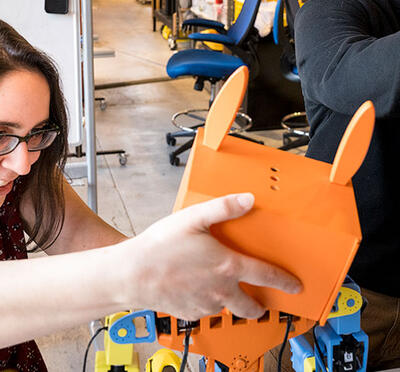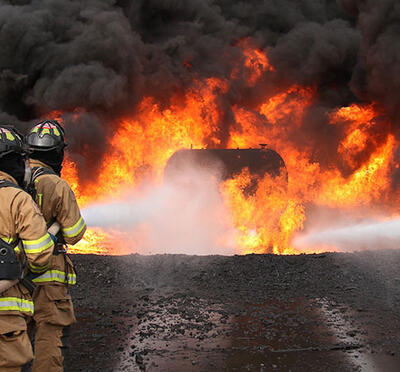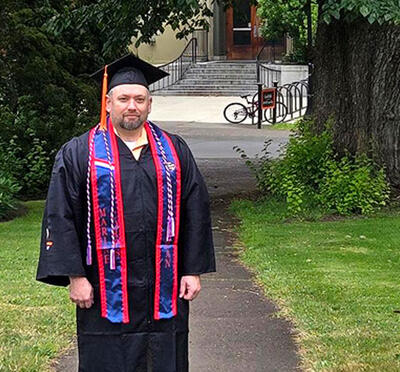When Liam Vincent arrived at Oregon State University, he brought with him a unique passion: building and racing human-powered submarines. Now a senior in mechanical engineering, Vincent undertook a journey that has not only shaped his own college experience but has also launched a new opportunity for hands-on, multidisciplinary engineering at Oregon State.
“I’ve been racing human-powered submarines for a little over a decade,” Vincent said, reflecting on his early start with the Kids Into Discovering Science program as a 9-year-old in Maryland. “It’s been a huge part of my life.”
That lifelong enthusiasm became the spark for something unprecedented at Oregon State.
A vision beneath the surface
In spring 2023, Vincent and fellow student Po-Yen Huang began laying the groundwork for what would become the Oregon State University Human-Powered Submarine team.
“I wanted to foster an interdisciplinary, hands-on project for students from all backgrounds,” Vincent said.
The process of standing up the team was anything but simple.
“It took six months to establish the club, a year to become a department student organization, and almost 18 months to finalize all the details with the university,” Vincent said.
The team’s mission was ambitious: design, build, and race a “wet” submarine — one that is fully submerged and powered solely by the pilot inside — at the International Submarine Races.
“When I first heard about the project, I thought Liam was a little bit crazy,” said team member April Martus, a chemical engineering student. “But he did it.”
From whiteboard to water
The team’s journey from concept to competition was a true test of perseverance.
Students from the College of Engineering and other disciplines, including economics and oceanography, joined the effort, forming subteams focused on hull design, propulsion, steering, emergency systems, and diving. They built the 9-foot-long sub in Merryfield’s iLab makerspace on a custom-built 10-foot-long table.
The team’s first in-water test of their submarine, Castorea, came in April 2025, just three months before their inaugural competition in Maryland.
“The test was successful in that we learned a lot,” said Martus, who served as one of the sub’s pilots, along with Vincent. “We fractured our gearbox. Our propulsion system completely broke and had to be gutted. Some steering cables broke. Our nose cone had to be completely reworked. Basically, every system except for the hull itself had to be rebuilt.”
By the team’s third in-water test, they had worked out all the kinks, and Castorea was ready for competition.
Making a splash at ISR18
In June, Vincent led 15 students to the 18th International Submarine Races, hosted by the Foundation for Underwater Research and Education at the Naval Surface Warfare Center in Carderock, Maryland. The competition brought together 18 teams from around the world, each vying to push the boundaries of underwater engineering.
On the very first day of racing, Oregon State’s team passed both dry and wet inspections and crossed the finish line on their first attempt.
“Our goal was to cross the finish line. We defined this as our success due to our youth as a team,” Vincent said. “Upon crossing, tears of joy were seen from many of the students, for they had been working tirelessly towards this goal for nearly two years.”
Throughout the week-long competition, Castorea crossed the finish line 11 times, achieving a top speed of 1.98 knots. The team’s efficiency earned them one of two Smooth Operator awards, a recognition of their ability to stage, race, troubleshoot, and prepare for each run with professionalism. They also won, unofficially, the loudest cheer award.
“We saw amazing teamwork and camaraderie both within our team and between teams,” Vincent said. “It was really great to see.”
For his individual efforts in shepherding the team, the Foundation for Underwater Research and Education awarded Vincent the Poseidon International Scholarship.
“It is pretty impressive to start a club, navigate risk management, insurance, university policies, identify the critical partners, build the team, learn the skills, build the sub, and end up at competition as one of the most consistent teams crossing the finishing line at competition the first time out,” said senior faculty research assistant Chris Holm, Castorea’s faculty advisor. “Many experienced teams struggled with propulsion, buoyancy, steering, emergency system failures, and sub stability. They should be really proud of what they all achieved.”
Building a legacy
The OSUHPS team’s success was about more than just speed. Their journey was marked by innovation, resilience, and a commitment to education.
“We wanted to inspire future engineers and explorers through education and partnerships,” Vincent said.
The team’s efforts were recognized back home as well: OSUHPS received Oregon State’s Best Starting Organization Award, and Vincent himself was honored with the Rising Star Award for emerging leaders.
Funding and support came from a variety of sources, including the Naval Nuclear Laboratory, which develops advanced naval nuclear propulsion technology, and the Oregon State community through Dam Proud Day, which has raised about $5,000 for the team over the past two years. The team received donations of carbon fiber from Chomarat to build the vessel’s hull, and Diventures covered the cost of dive gear for the races in June. The College of Engineering was also an important sponsor.
Looking ahead
As Vincent prepares to graduate, he’s focused on ensuring the team’s legacy continues.
“I didn’t want it to be just a one-off project. I wanted to establish something that would carry on for generations to come,” Vincent said.
The team is already planning for future competitions and is sponsoring capstone projects to keep the innovation going. Airtech offered supplies for recent capstone projects.
“This is the most critical time for this team,” Holm said. “We have a fantastic opportunity to take our lessons learned and come back to competition in 2027 even stronger and more competitive. But we will need to recruit some fresh talent to carry us forward, as our competition has had a 30-year head start. That said, with a motivated team, I think we can win.“
Reflecting on the journey, Vincent is proud of what the team has accomplished. “It has been an honor to see this vision come to fruition and create a unique opportunity for students,” he said.




